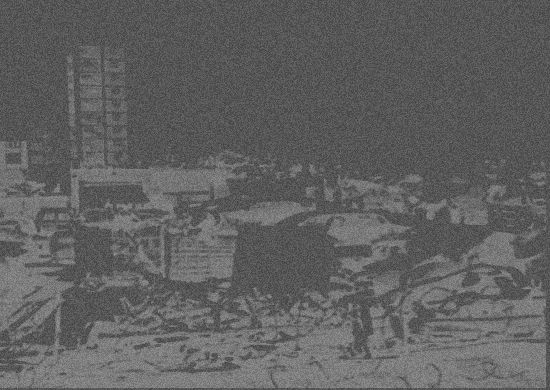
We Live Above The Mutilated Floor
by Oliver Zarandi
Moving
I realised I wanted to eat London when I moved into a warehouse conversion in Hackney in 2014.
It was February and my girlfriend and I were looking for a place to live. She saw an advert and thought it looked nice so she called the agency up.
Meet me there, she text and so I went over and walked through the garage and past what seemed to be a factory. The windows had bars on them and the windows themselves were only open ajar – and would always be opened this much in the year that I ended up living there – to give the Chinese workers some fresh air over their 12 hour shifts.
We met the estate agent just outside some sea containers, a coat rack with several dead chickens hanging from them just to his right. When we went to look at the warehouse, it was around 10m2, the floors a light-coloured wood and a bed-sized mezzanine level on the left hand side of the door. The far wall was white brick and a large window looked out over a garage that was filled with car parts.
I could see windshields, axels, steering wheels, leather seats, barbed wire, hoods, fenders, council estates, trees, no leaves.

VHS
I am obsessed with the little details but often fail to see the bigger picture. This is something I have had since I was a child, pausing a VHS of a television show or a film and studying the background, analyzing the city in the background, the texture of the city and the texture of the television screen. There are two good examples of this. In Hannah and Her Sisters, when Isaac (Woody Allen) walks past the bookshelf, I noticed the spine of E.L. Doctorow’s Loon Lake.
What does this mean? Nothing, perhaps. But to me it means everything. It’s a little secret that only I know. It’s this hunger for knowledge, this desire to excavate layers and find something nobody else – or not many people – have seen before. I think back to those days watching Seinfeld and wondering why Jerry had a VHS of True Colors on his shelf.
I see this hunger to excavate films and television and the city as a method of time travel. Ever since I recovered from my eating disorder – I didn’t eat proper solid food from the ages of 12 to 18 – I look back on those years and realise I had a hunger to return to something. I felt nostalgic for scenes I’d watched in films, for the little things I’d see in the background.
Nostalgia: nostos, in Greek, to return home. Algos, pain. I sometimes think is it a painful return to something, or a return to something painful? I wonder if all young men and women who have had or have eating disorders all feel this way, who all embrace the pain of returning to something past, who hold onto tokens and live inside of books and films, who feel like they want to climb inside of fiction and reside there.
The Textures of Bricks/Condoms/Food
When we moved into the warehouse, I started to become interested in the textures of things. The walls, the bricks, the way the light hit the cars in the garage just below my window.
The bricks, to me, were comfortable, comfortable enough to run my knuckles across their zigzags and pretend it was braille. My warehouse was a secret language that only I could read.
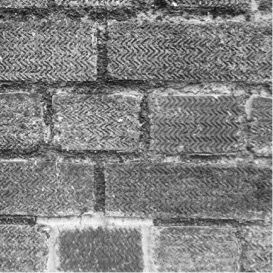
Every day, new items would appear in the courtyard. Fridges and televisions, the old cathode ray tube ones, their screens smashed in. There were old armchairs and chesterfield sofas. Slashes had been made into the chesterfield’s seats, the leather parted on either side of the slash like a vagina. Inside there was sponge and wood. Sometimes when passing the chesterfield, I would poke a finger inside it and wondered if anybody was watching.
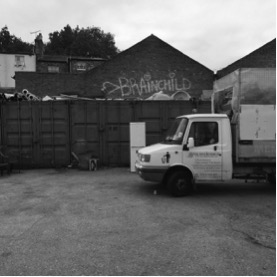
There were condoms, too, spread out over the courtyard and the garage. Some condoms were rolled out all the way and lay on the floor filled with yellow semen. Other condoms were only rolled out a little bit and had, perhaps, been worn on a blunt penis. There was a game that my girlfriend and I would play – though, truth be told, I don’t know how much she enjoyed the game – wherein we would count the condoms. I think I once counted at least 14.
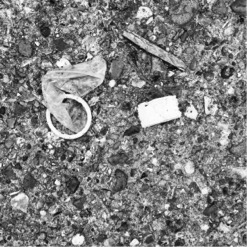
I read somewhere that yellow semen is caused, perhaps, by a prostate infection. Just looking at those condoms in the car park forced me excavate it as a location, to not just look at the whole, but to look at the texture of the condom, to see the grit from the concrete staining the latex like pepper, to look as closely as I could to look in microscopic detail at the colour and consistency of the semen. Searching on Google makes me feel like a poor man’s Philip Marlowe and results such as ‘yellow cum – is that normal’ only compound this feeling.
Living close to Shacklewell Lane, you realise that these condoms are not just making a random appearance. In the mornings, I would sometimes wake up early – or, often, return home late – and walk or cycle down Shacklewell Lane and through Hackney Downs. From a distance, I would see a woman and think nothing of it. But then, as she got closer, her face would appear more bruised, the texture of her face reminding me of the condom itself, yellowed and gritty. Early in the morning on the Downs, I cycled and looked at the low level mist that shrouded it. I cycled around and around and there in the park were the prostitutes, arms folded, walking slowly around and around the park too.
Although they walk around Hackney Downs and up and down Shacklewell Lane, they eventually arrived at the warehouse carpark. At night it used to be pitch black there and there were used Volvos with the windows smashed in. Sometimes the boot was entirely torn off and it was there that I imagined they had sex. I imagined the textures of their backs as they got up from getting fucked, the smashed window, the glass, rhinestoning their backs like cheap diamonds.
When I look at all of these textures, I find myself comparing it to food. The texture of those bricks, the condoms, the metals, the cars, they are almost too much. Even now, since I have moved out, I find that living in London is overwhelming. The touch of the brick makes me want to eat it. I am not content with knowing it: I must have it. I try to imagine what the brick might taste like in my mouth, how it might feel. I even Google what London brick’s consistency is like. It is a mixture of distinctive, soft yellow clay and, as a result of time and dirt, blue and black. In 1956 the Clean Air Act attempted to clean these bricks and restore buildings to their natural colour after the Great Smog of 1952. But London finds a way of dirtying itself year after year and now, on many London streets and avenues and alleyways, there is dirt and under that dirt and the texture of the bricks there is a history too.
So is the act of touching these bricks and my desire to eat them a desire to own London’s history? I used to dream of London bricks, their characteristic black and blue colour, when I was a child. Perhaps my desire to eat London, then, is an act of returning home.
Even after recovering from my eating disorder, I find it difficult to consume certain textures. Carrots for example. Noodles. Some cheeses put me on edge. Fatty meats become knots inside my mouth. Chewing gum is to be avoided, on the whole, because after I dispose of it, I wonder to myself: did I dispose of it? And then I create ideas in my head that I have swallowed the gum and then the large, thick ball starts to pulse in my throat, the phantom gum, choking me and killing me.
And so, going back to that idea of returning to that dreamlike, ideal past, it is, perhaps, impossible. In my head, I want to consume things to return to that time, I want to eat London, but I cannot.
Choking
People are choking on London all the time. Walking down alleyways in Soho and rubbing your hands on the smooth tiles and inhaling the smell of urine. Walking past a church on St Martin’s Lane and pressing your face into the sandstone and wondering if you can feel a heartbeat or not. Or perhaps it walking into Covent Garden and seeing a spot in the ground where you once kissed somebody on a bench – a stranger – but now that bench is gone but the space isn’t gone because space is space and you walk over to it and pretend to sit down in the same position you did, your legs squatting and sitting on an invisible bench and you try and fit your body, the body you have now, into your ghost self and you wonder if, by some miracle, that ghost self might actually hold your weight and take you back, might return you.
Reading, constant reading, but not the reading of fingers on bricks, but the reading of eyeballs and the mind looking at words and interpreting those words. David Meltzer’s Doom Cusp:
“acute homesickness”
Greek: nostos
“return home”
algos “pain”
Nostalgia
And then:
fat w/past
bogged down
in the tense present
And then:
A puzzle no matter
How I move it
Never solves itself
Trying to eat the city, to feel the city, to fuck the city, to read the city. Walking on from Covent Garden, you move to different areas of the city. Down Drury Lane and up Tavistock Street. It is dark here and in your memory there are no street lamps here. The buildings are tall and black fire escapes creep across them like shadows. It doesn’t look like London, at least not London in the present, and you wish this street would stay the same, you walk down it and look inside people’s windows, little windows with the curtains drawn, potted plants, statues, some curtains open and inside the lights are off, the dullness of interiors.
Avoiding some areas which hold memories. Relationships are a series of places you can’t return to, you say and it’s true, you cross out areas on your mental map, you cross the street because up ahead is a space where you held somebody’s hand and you don’t want to breathe in that air, up ahead is a place where you choked on a piece of food, and if you walk through that specific space, that specific air, you will become infected with the memory. Memory as infection, London as a space to choke on, to enter your throat and stay there. London as a memory that nobody else is allowed to read. Memories that have no time to stew, that are immediately created. “History is on our heels, following us like our shadows, like death.”[1]
Areas that seem empty but are filled with life. Heathrow Airport, where the holiday itself is the departures lounge, not the country. Watching escalators and the lights beneath them, the machinery of facilitation. Overfilled bins. Tissues filled with phlegm as a sexual image. A Burger King sign reflected in the just-polished floor, its lettering turned from English to something resembling Russian.
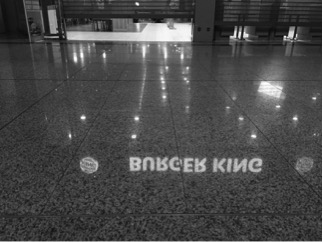
Travelling to Gunnersbury and finding a Russian orthodox church, its blue dome. You remember a group of Russian students who told you that they had visited it. You say nothing but you think of Burger King at its writing and wonder if there is some secret Russian thread running through your version of London.
Wandering through a version of London lost. Bishopsgate. Security cameras, signs, signs warning pedestrians to stay away. Banks. The iron wall. The 1993 Bishopsgate bombing where the IRA detonated a bomb in the heart of London’s financial district. A fertiliser bomb. On a Sunday. And one person died, a reporter. 500 tons of glass and rubble. You remember interviewing a photographer about this, thinking that he was there when it happened but he wasn’t. I was in bed, he said and you are disappointed that he wasn’t there at the scene of the bombing. You see pictures of Bishopsgate, the road covered in glass and the road reflects the sky, creating some sort of double sky, there in the heart of the city.
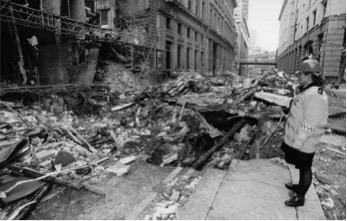
You wander around Bishopsgate for hours, the image of yourself reflected back at you, thousands of windows and empty office spaces, space being sold by the square foot, empty spaces protected by security guards, empty space with the lights on.
The hunger of looking inside stranger’s houses. In Hampstead, winding up the hill, walking past the church and then down again, walking past houses and pressing your face up against windows, looking at lampshades, sofas, curtains, the texture of the carpets, the bookshelves, pretending those bookshelves are the ones you saw inside of your television, looking at what people read, looking at the spines of the books and thinking how thick the pages are, that perhaps you could eat those books, take down that Colm Tóibín book from the cleanest shelf you’ve ever seen and chewing every page and choking on it, the words no longer words but just pulp in your stomach, your body now one with language, but not really, not really at all.
Overpass
Michel De Certeau writes: “The spectator can read in it a universe that is constantly exploding.”[2]
He also goes on to say that the city creates “the fiction that creates readers, makes the complexity of the city readable.”
London is an illegible city. It is a city of walkers but nobody can read its text. Although there have been countless books about London and its history or, better still, histories, it is, ultimately, a city that defies us, cannot be held down. It frustrates.
How can we get closer to it? The running of fingers across its textures, for example. The overpass in Hackney Wick. As the cars below drive at 80mph, the round, metal pole of the overpass forms condensation. Imagine licking this. Instead of reading London, drink from it.
Or perhaps my inability to eat from the ages of 12 to 18, my inability to swallow solid food, has corrupted me. Perhaps it has destroyed my ability to read a city and my ability to enjoy it. When I walk around London, I wonder if others get the same urge I do, the same hunger for its bricks, its histories, its layers, its textures.
Exit
We eventually left the warehouse conversion. A few weeks into living there we learnt that there was a female wrestling club above us. They have a website. Old men would wait outside the bottom doors and tell me about the women upstairs, how nice they were, how fun it was. I looked them up online and saw thick thighs choking men.
After spending a year there, we decided that enough was enough. We lived in that single room and for many months we had no curtains. The sun shone directly onto us and we would wake in a sort of red eyed tiredness. The warehouse accumulated dirt. We had a leak in the final few weeks because the upstairs flat had a party and left the taps on. I went upstairs with my neighbour and we knocked on the door and said did you know there was a leak and they said no. I knew they were lying. I looked inside their room. The curtains were drawn and I could silhouettes lying on sofas, smoking.
*
Sitting here now, I read a poem by Emily Berry. It’s called Sweet Arlene and the first line is:
In Arlene’s house, we live above the mutilated floor.
Something in this line resonates. The fact that I once lived not just above the mutilated floor, but lived on and below it. Perhaps I’ve always lived in mutilated places. And even though I’ve moved out of that warehouse conversion and even though I try not to think about it, I do. I heard that they were demolishing the garage next to the warehouse and that those residents are now faced with eviction. But as I sit here, as I sit here and write, I feel a sense of returning, of returning to the pain, I am reminded of my eating disorder, I am half in my chair and half out of my chair and feel like returning to that home and eating it entire.
[1] Marc Augé, Non-Places: An Introduction to Supermodernity, p.22 (Verso: London, 2008)
[2] Michel de Certeau, The Practice of Everyday Life, p.91 (University of California Press, USA, 1988)
Oliver Zarandi‘s work has recently appeared or is forthcoming in Fanzine, Hotel, Vol.1 Brooklyn, Queen Mobs Teahouse and The Quietus. He is working on his first novel.
Follow Vol. 1 Brooklyn on Twitter, Facebook, and sign up for our mailing list.
